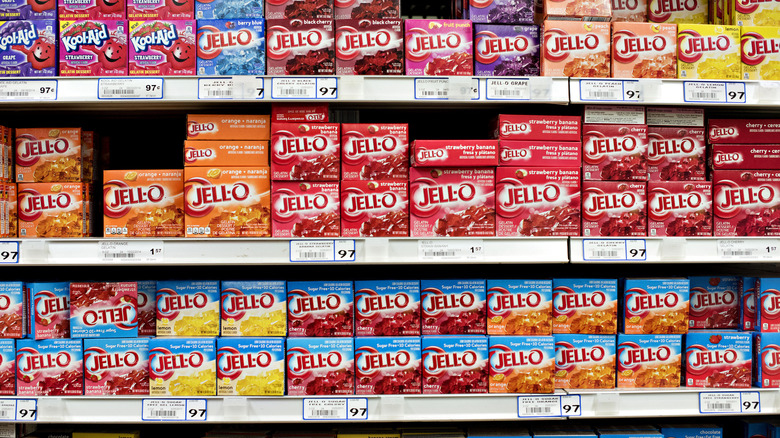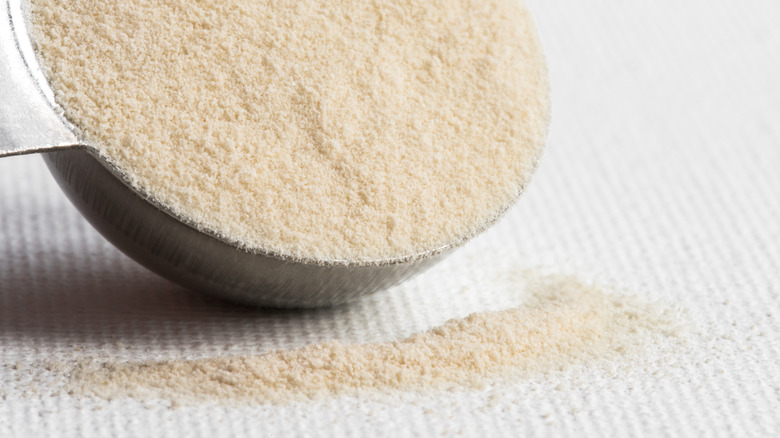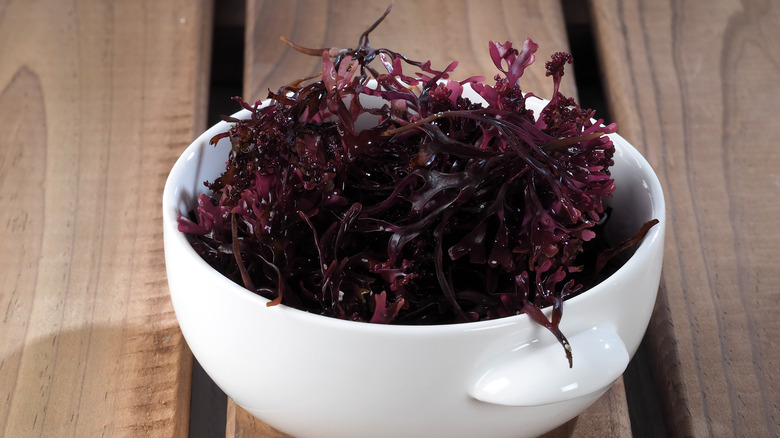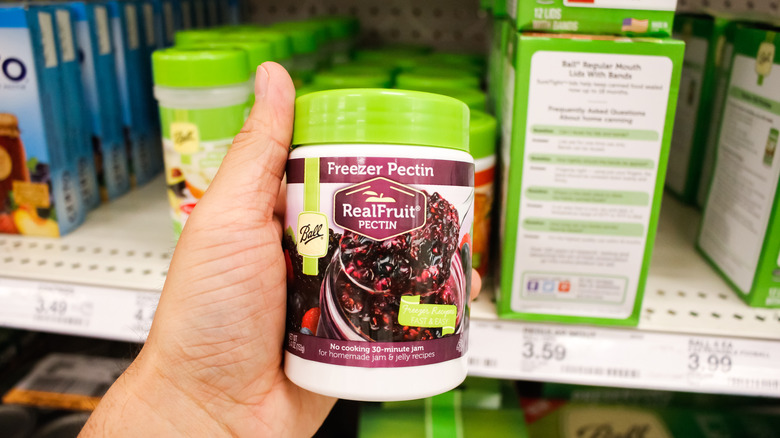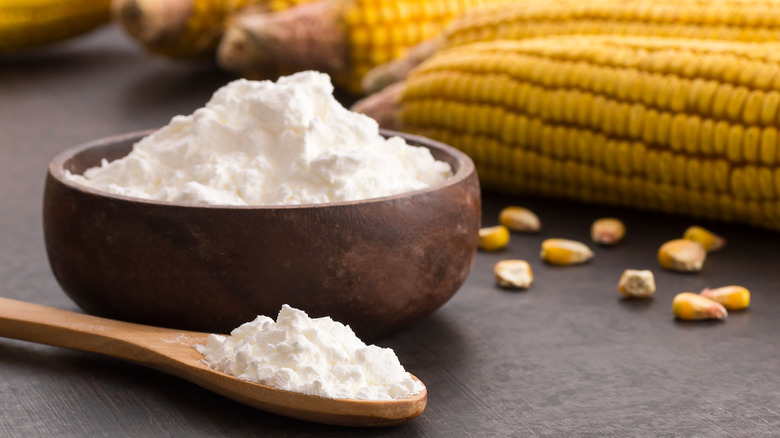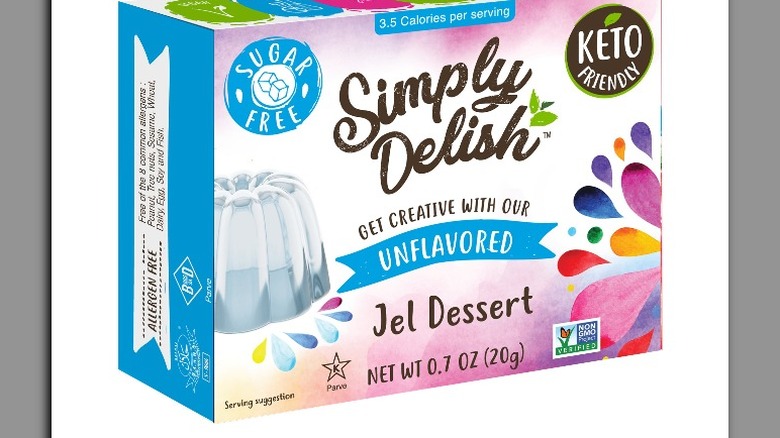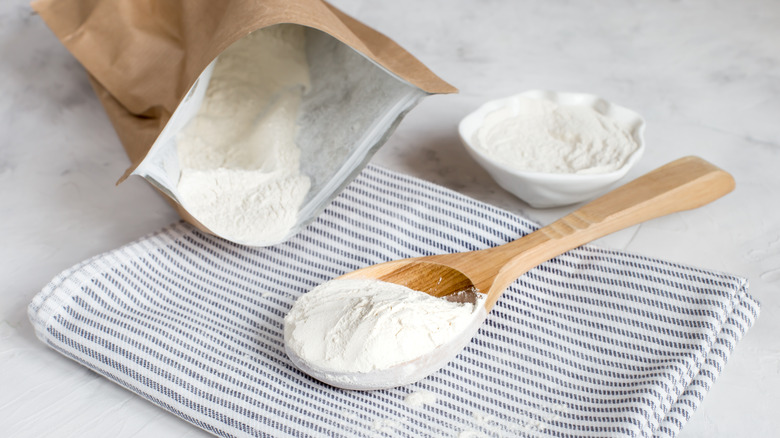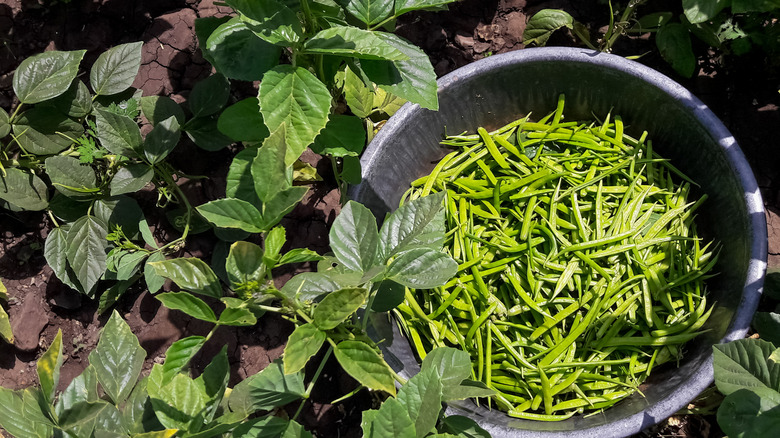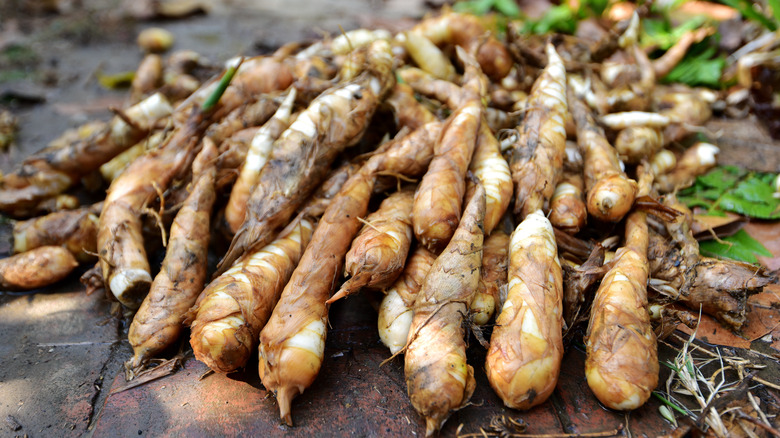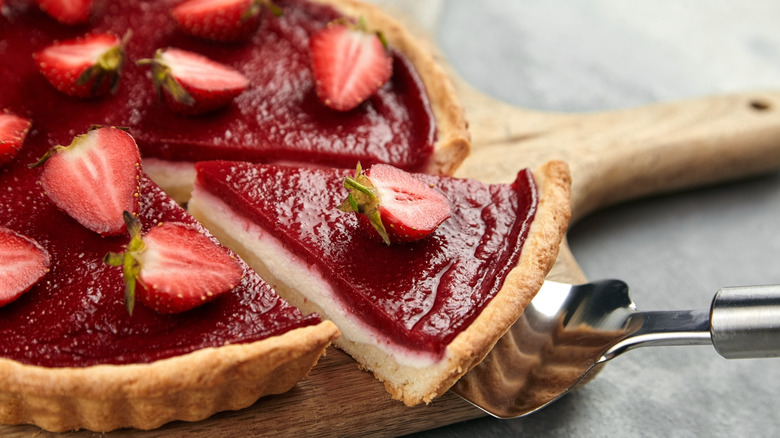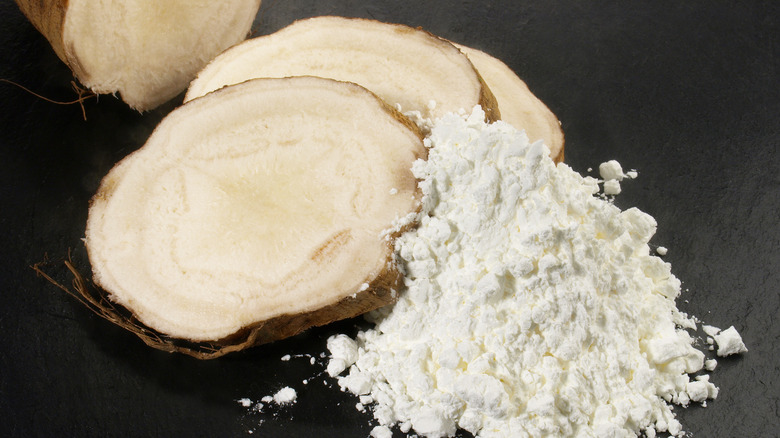10 Best Substitutes For Gelatin
Gelatin — that prerequisite ingredient for jello desserts and occasionally found in baking and sauce recipes — is, for many home cooks, not terribly familiar. What exactly is it? How is it made? Is it really made from animal bits?
Well, yes. Gelatin, as PopSugar explains, is a form of collagen that's derived from animal parts, typically from cows and pigs. Some of the items that are left over after the rest of the animal has been processed — things like skin, bones, and cartilage, and even horns in some cases — are boiled for a lengthy period of time until the resulting, refined gelatin is on the clearer side and completely odorless and tasteless. The gelatin, which is packed full of amino acids, is dried and that's what you get when you pick up a box of Jell-O at the grocery store. When you then dissolve the dried or sheet gelatin, a chemical reaction occurs, says ThoughtCo, which creates a jiggly, bonded, thick mass that you need for recipes such as Jell-O desserts, panna cotta, or homemade marshmallows.
But if you're not keen on the idea of adding a healthy helping of cow skin and horns to your next dessert, what can you use to replace gelatin? Is there anything that can easily replicate its unique chemical makeup? Here are 10 substitutions to consider.
1. Agar-Agar
One of the most popular (and most effective) vegan substitutes for gelatin, agar-agar (sometimes also referred to as kanten or simply agar) is derived from Red Sea algae, says One Green Planet. Much like gelatin, it has no smell, taste, or color, and it's useful for thickening or firming up your wobbly desserts. However, agar-agar firms up a little more thickly than gelatin, meaning your Jell-O might not be as wobbly as you want; it does, though, perform better than gelatin under high temperatures. Like gelatin, agar-agar comes in dried powder form, but also in flake and bar form. It's typically found in the health food or international aisle at the grocery store.
When using agar-agar powder, substitute an equal amount of agar-agar for the gelatin powder in your recipe. When using agar-agar flakes, use one tablespoon agar-agar flakes for every one teaspoon of gelatin you need. When using agar-agar bars, use half an agar-agar bar for every one teaspoon of gelatin you need.
2. Carrageenan
Carrageenan, which is derived from seaweed and sometimes called carrageen or Irish Moss, is less popular than agar-agar, at least for home cooks looking for a gelatin substitute. It's more widely used in the commercial food industry, as a vegan thickener or gelling agent, and can be found, as Scientific American points out, in items such as pudding, jelly, and ice cream. There's been a bit of controversy surrounding carrageenan, with debates on whether or not the ingredient is ideal for human consumption, but no conclusive evidence has been found to dictate whether the ingredient is or isn't healthy. Your best bet for purchasing carrageenan is online. PETA recommends purchasing carrageenan in its moss form and then allowing it to soak until it swells. Then, add the carrageen to the liquid you need to set for your recipe, boil it for 10 minutes, and then remove the moss.
One ounce of carrageen is suitable for setting one cup of liquid. According to Fine Cooking, you need about 1¼ teaspoon of powdered gelatin for one cup of liquid, meaning one ounce of carrageen equals 1¼ teaspoon of powdered gelatin (and you can increase the amount of either for a firmer gel).
3. Pectin
Pectin, derived from fruits and veggies, is often used in preserves, jellies, and jams as a binding and gelling agent, Food Network explains. A starch, pectin can be purchased both in a dry or liquid form and it also comes in two varieties: high methoxyl and low methoxyl. The former further comes in two varieties: fast setting and slow setting. The low methoxyl variant is low in sugar; you'd usually only use it when making a no-sugar or low-sugar jam or jelly. If using a recipe that calls for pectin, it will usually dictate which of the above varieties you'll want to use for best results. If you use pectin in place of gelatin, you'll notice that the pectin firms up a little harder; also, note that pectin generally does require sugar in order to firm up, so it's only a good gelatin substitute if you're making a dessert.
Unfortunately, there's no concrete recipe for replacing gelatin with pectin. Instead, Livestrong recommends experimenting with the pectin until you reach the desired consistency.
4. Cornstarch
Most home cooks have used cornstarch to thicken up sauces and soups, but if you're in a pinch, you can also use cornstarch as a replacement for gelatin, in certain recipes. You likely won't want to use cornstarch to make your favorite panna cotta, but, for example, if you're making a recipe that calls for gelatin in a sauce, cornstarch will do the job. Just note that your sauce will end up more like a sauce made with cornstarch (a gravy) than a sauce made with gelatin (which is usually more akin to a glaze). Also note that gelatin thickens an item as it cools, whereas cornstarch thickens an item as it heats up, so you'll have to adjust your recipe and expectations accordingly.
To use cornstarch as a thickener, you want to create a slurry first. Using a 1:1 ratio of cornstarch to water, mix together before adding to your dish.
5. Vegan Jel
If you want the simplest, easiest replacement possible for your typical box of powdered gelatin, look to vegan "jel." Available from a few different brands, this product is essentially a gel dessert mix that's vegan and gluten-free and that is packaged just like Jell-O unflavored gelatin, looks just like Jell-O unflavored gelatin, and behaves like Jell-O unflavored gelatin. You add the dry powder mix to boiling water following the directions on the box, add it to your recipe, and then let it chill up and firm.
The ingredients for Bakol brand of vegan "jel") include evaporated cane juice, vegetable gum, citric acid, potassium citrate, and beet powder, along with some natural flavors (via Amazon). The gelling action comes from the vegetable gum, which is another popular substitute for traditional gelatin (via SFGate), but picking up a box of vegan jel and just following the directions right on the box is a lot easier than buying your own vegetable gum and sorting out the substitution measurements for yourself.
When using vegetable jel in place of your powdered gelatin, substitute equal amounts.
6. Xanthan Gum
You likely don't have a bag of xanthan gum (which comes as a fine, white powder) sitting in your pantry, unless you bake gluten-free items on occasion. Otherwise, you're probably more familiar with xanthan gum as simply being one of those mysterious items that show up often on ingredient lists of your favorite packaged foods. But xanthan gum, which you can find in everything from ice cream to salad dressing, is a stabilizer, binder, and food additive that's known for creating creamy, stable sauces and dessert items.
Available in just about any grocery store, in the baking aisle, xanthan gum can stand in for gelatin when you're making a creamy, thick pastry filling or a glaze, for example.
According to the RecipeTips glossary, use 1 teaspoon of xanthan gum for every 2 teaspoons of unflavored gelatin.
7. Guar Gum
Another vegetable gum that you can use in place of your gelatin, guar gum is made from the guar bean, a legume that looks a little like a green bean and is grown everywhere from India to the southern United States (via the Noble Research Institute). Guar gum is used in everything from food to hydraulic fracturing in the oil and gas industry, and you can buy it from most retailers, from Amazon to Walmart, from popular baking brands such as Bob's Red Mill.
A thickener and stabilizer, guar gum thickens without heat, but still retains its structure when heated, as Our Everyday Life explains. Guar gum can replace gelatin in baked goods and dairy desserts, but it's not a good fit for wet recipes that are mostly liquid, as guar gum cannot be mixed directly into those liquids; it needs some other dry ingredients, such as flour, or it'll clump up.
Use guar gum in place of gelatin at a ratio of ½ teaspoon of guar gum for every 2½ teaspoons of gelatin.
8. Arrowroot
A starch that's sometimes used in place of cornstarch, arrowroot can also be used to replace your gelatin in certain recipes. A thickening agent, it is best-suited to thicken up your liquids, making a nice sauce or even a limp jelly (via BBC Good Food), rather than making a firmer dessert item, like a marshmallow. Like when using cornstarch, it's ideal to make a slurry with your arrowroot before adding it to any hot mixtures and then to not allow your mixture to remain too long on the heat after adding the arrowroot (which can prevent thickening).
The good thing about using arrowroot to replace your gelatin rather than cornstarch? According to The Cook's Thesaurus, items thickened with arrowroot can be frozen and then thawed, whereas items thickened with cornstarch usually turn into a mess after freezing.
To replace your gelatin with arrowroot, use 2 teaspoons of arrowroot for every 1¼ teaspoon of powdered gelatin.
9. Instant Clear Gel
No, Instant Clear Gel isn't the same as the vegan "jels." Instead, Instant Clear Gel (sometimes spelled Cleargel, Clearjel, or Clear Jel, and sold by a range of brands, including King Arthur Baking) is a popular product used in canning and baking. A modified food starch, it's similar to cornstarch, but not quite the same thing. It thickens foods instantly – no cooking required – and can be used as a thickening agent in place of gelatin and even flour.
Clear Gel can be purchased in two forms, cook or non-cook (via everythingPies); the non-cook version is ideal for refrigerated desserts and some home cooks even use it to stabilize whipped cream. Just note that, if you're expecting a harder, stiffer gel, like what you might get with a pack of Jell-O, Instant Clear Gel can't firm up quite that much. Because of this, if you're attempting to substitute it for gelatin in a recipe, you may need to play around with the quantities a bit until you achieve the results you're after.
10. Kudzu
Also known as East Asian arrowroot or kuzu, kudzu may be more familiar to home cooks living in the American South, as an invasive plant species. However, the plant's starchy roots can be harvested for food and the roots are made into a starch similar to arrowroot. According to MasterClass, kudzu starch is typically used in place of potato starch, cornstarch, or rice flour, but you can also use it similarly to how you'd use cornstarch in place of gelatin (via Tastessence). When using it to thicken dessert items, you'll want to mix the powder with a cold liquid first, before adding it into the liquid you want to thicken.
According to Cook's Info, use 1½ tablespoons of kudzu starch per 1 cup of liquid to be thickened, or 2 tablespoons if you want more of a gel-like consistency. Based on this, it appears that 1½ tablespoons of kudzu should equal around 1¼ teaspoon of powdered gelatin.
